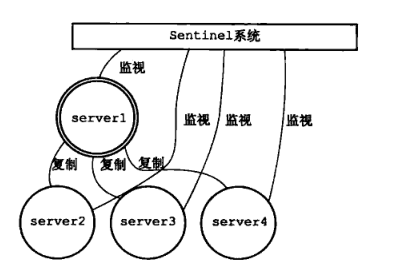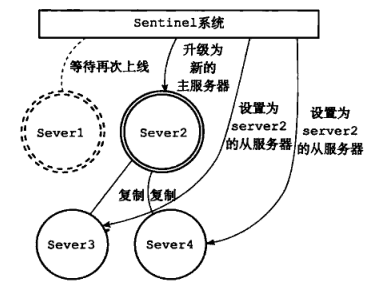一、Redis-Sentinel
Redis-Sentinel是redis官方推荐的高可用性解决方案, 当用redis作master-slave的高可用时,如果master本身宕机,redis本身或者客户端都没有实现主从切换的功能。 而redis-sentinel就是一个独立运行的进程,用于监控多个master-slave集群, 自动发现master宕机,进行自动切换slave > master。
1、Redis Sentinel简介
Sentinel(哨兵)进程是用于监控redis集群中Master主服务器工作的状态,在Master主服务器发生故障的时候,可以实现Master和Slave服务器的切换,保证系统的高可用,其已经被集成在redis2.6+的版本中,Redis的哨兵模式到了2.8版本之后就稳定了下来。一般在生产环境也建议使用Redis的2.8版本的以后版本。哨兵(Sentinel) 是一个分布式系统,你可以在一个架构中运行多个哨兵(sentinel) 进程,这些进程使用流言协议(gossipprotocols)来接收关于Master主服务器是否下线的信息,并使用投票协议(Agreement Protocols)来决定是否执行自动故障迁移,以及选择哪个Slave作为新的Master。每个哨兵(Sentinel)进程会向其它哨兵(Sentinel)、Master、Slave定时发送消息,以确认对方是否”活”着,如果发现对方在指定配置时间(可配置的)内未得到回应,则暂时认为对方已掉线,也就是所谓的”主观认为宕机” ,英文名称:Subjective Down,简称SDOWN。有主观宕机,肯定就有客观宕机。当“哨兵群”中的多数Sentinel进程在对Master主服务器做出 SDOWN 的判断,并且通过 SENTINEL is-master-down-by-addr 命令互相交流之后,得出的Master Server下线判断,这种方式就是“客观宕机”,英文名称是:Objectively Down, 简称 ODOWN。通过一定的vote算法,从剩下的slave从服务器节点中,选一台提升为Master服务器节点,然后自动修改相关配置,并开启故障转移(failover)。
2、Sentinel(哨兵)进程的作用:
(1) 监控(Monitoring): 哨兵(sentinel) 会不断地检查你的Master和Slave是否运作正常。
(2)提醒(Notification):当被监控的某个Redis节点出现问题时, 哨兵(sentinel) 可以通过 API 向管理员或者其他应用程序发送通知。
(3)自动故障迁移(Automatic failover):当一个Master不能正常工作时,哨兵(sentinel) 会开始一次自动故障迁移操作,它会将失效Master的其中一个Slave升级为新的Master, 并让失效Master的其他Slave改为复制新的Master;当客户端试图连接失效的Master时,集群也会向客户端返回新Master的地址,使得集群可以使用现在的Master替换失效Master。Master和Slave服务器切换后,Master的redis.conf、Slave的redis.conf和sentinel.conf的配置文件的内容都会发生相应的改变,即,Master主服务器的redis.conf配置文件中会多一行slaveof的配置,sentinel.conf的监控目标会随之调换。
3、Sentinel(哨兵)进程的工作方式:
(1)每个Sentinel(哨兵)进程以每秒钟一次的频率向整个集群中的Master主服务器,Slave从服务器以及其他Sentinel(哨兵)进程发送一个 PING 命令。
(2)如果一个实例(instance)距离最后一次有效回复 PING 命令的时间超过 down-after-milliseconds 选项所指定的值, 则这个实例会被 Sentinel(哨兵)进程标记为主观下线(SDOWN)。
(3)果一个Master主服务器被标记为主观下线(SDOWN),则正在监视这个Master主服务器的所有 Sentinel(哨兵)进程要以每秒一次的频率确认Master主服务器的确进入了主观下线状态。
(4)当有足够数量的 Sentinel(哨兵)进程(大于等于配置文件指定的值)在指定的时间范围内确认Master主服务器进入了主观下线状态(SDOWN), 则Master主服务器会被标记为客观下线(ODOWN)。
(5)在一般情况下, 每个 Sentinel(哨兵)进程会以每 10 秒一次的频率向集群中的所有Master主服务器、Slave从服务器发送 INFO 命令。
(6)当Master主服务器被 Sentinel(哨兵)进程标记为客观下线(ODOWN)时,Sentinel(哨兵)进程向下线的 Master主服务器的所有 Slave从服务器发送 INFO 命令的频率会从 10 秒一次改为每秒一次。
(7)若没有足够数量的 Sentinel(哨兵)进程同意 Master主服务器下线, Master主服务器的客观下线状态就会被移除。若 Master主服务器重新向 Sentinel(哨兵)进程发送 PING 命令返回有效回复,Master主服务器的主观下线状态就会被移除。
4、Redis Sentinel工作简单原理图

在Server1 掉线后:

升级Server2 为新的主服务器:

二、redis命令整理
官网地址:http://redisdoc.com/ redis-cli info #查看redis数据库信息 redis-cli info replication #查看redis的复制授权信息 redis-cli info sentinel #查看redis的哨兵信息
三、Redis Sentinel配置
(一)准备三个redis数据库实例(三个配置文件,通过端口区分)
1、主节点master的redis-6379.conf
port 6379 daemonize yes pidfile "/data/6379/redis.pid" loglevel notice logfile "/data/6379/redis.log" dbfilename "dump.rdb" dir "/data/6379"
2、从节点slave的redis-6380.conf
port 6380 daemonize yes pidfile "/data/6380/redis.pid" loglevel notice logfile "/data/6380/redis.log" dbfilename "dump.rdb" dir "/data/6380" slaveof 127.0.0.1 6379
3、从节点slave的redis-6381.conf
port 6381 daemonize yes pidfile "/data/6381/redis.pid" loglevel notice logfile "/data/6381/redis.log" dbfilename "dump.rdb" dir "/data/6381"
slaveof 127.0.0.1 6379
4、启动主节点和从节点的redis服务
[root@localhost redis-4.0.10]# redis-server redis-6379.conf [root@localhost redis-4.0.10]# redis-server redis-6380.conf [root@localhost redis-4.0.10]# redis-server redis-6381.conf
5、确定主从关系
在主节点上查看主从通信关系
[root@master ~]# redis-cli -p 6379 info replication # Replication role:master connected_slaves:2 slave0:ip=192.168.119.10,port=6380,state=online,offset=407,lag=0 slave1:ip=192.168.119.10,port=6381,state=online,offset=407,lag=0 master_repl_offset:407 repl_backlog_active:1 repl_backlog_size:1048576 repl_backlog_first_byte_offset:2 repl_backlog_histlen:406
在从节点上查看主从关系(6380、6381)
[root@slave 192.168.119.11 ~]$redis-cli -p 6380 info replication # Replication role:slave master_host:192.168.119.10 master_port:6379 master_link_status:up master_last_io_seconds_ago:3 master_sync_in_progress:0 slave_repl_offset:505 slave_priority:100 slave_read_only:1 connected_slaves:0 master_repl_offset:0 repl_backlog_active:0 repl_backlog_size:1048576 repl_backlog_first_byte_offset:0 repl_backlog_histlen:0
此时可以在master上写入数据,在slave上查看数据,此时主从复制配置完成
(二)开始配置Redis Sentinel
1、准备三个哨兵,准备三个哨兵的配置文件(仅仅是端口的不同26379,26380,26381)
redis-sentinel-26379.conf配置文件写入如下信息
#Sentinel节点的端口 port 26379 dir /var/redis/data/ logfile "26379.log" #当前Sentinel节点监控 192.168.119.10:6379 这个主节点 #2代表判断主节点失败至少需要2个Sentinel节点节点同意 #mymaster是主节点的别名 sentinel monitor mymaster 192.168.119.10 6379 2 #每个Sentinel节点都要定期PING命令来判断Redis数据节点和其余Sentinel节点是否可达,如果超过30000毫秒30s且没有回复,则判定不可达 sentinel down-after-milliseconds mymaster 30000 #当Sentinel节点集合对主节点故障判定达成一致时,Sentinel领导者节点会做故障转移操作,选出新的主节点, 原来的从节点会向新的主节点发起复制操作,限制每次向新的主节点发起复制操作的从节点个数为1 sentinel parallel-syncs mymaster 1 #故障转移超时时间为180000毫秒 sentinel failover-timeout mymaster 180000
通过命令快速生成redis-sentinel-26380.conf,redis-sentinel-26381.conf两个文件
sed "s/26379/26380/g" redis-sentinel-26379.conf > redis-sentinel-26380.conf sed "s/26379/26381/g" redis-sentinel-26379.conf > redis-sentinel-26381.conf
2、启动三个哨兵
redis-sentinel redis-sentinel-26379.conf redis-sentinel redis-sentinel-26380.conf redis-sentinel redis-sentinel-26381.conf
3、检查哨兵的通信状态
redis-cli -p 26379 info sentinel
查看结果如下之后,表示哨兵正常
[root@localhost redis-4.0.10]# redis-cli -p 26379 info sentinel # Sentinel sentinel_masters:1 sentinel_tilt:0 sentinel_running_scripts:0 sentinel_scripts_queue_length:0 sentinel_simulate_failure_flags:0 master0:name=s15master,status=ok,address=127.0.0.1:6381,slaves=2,sentinels=3
4、杀死一个redis主库,6379节点,等待30s以内,检查6380和6381的节点状态
kill 6379主节点 redis-cli -p 6380 info replication redis-cli -p 6381 info replication #如果切换的主从身份之后,(原理就是更改redis的配置文件,切换主从身份)
5、恢复6379节点的数据库,查看是否将6379添加为新的slave身份